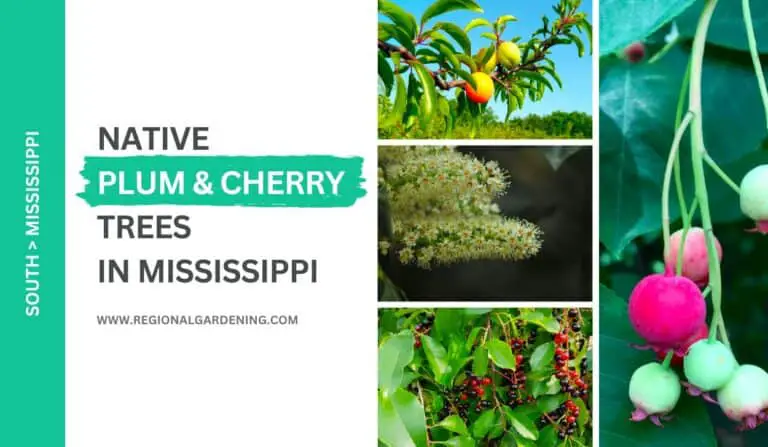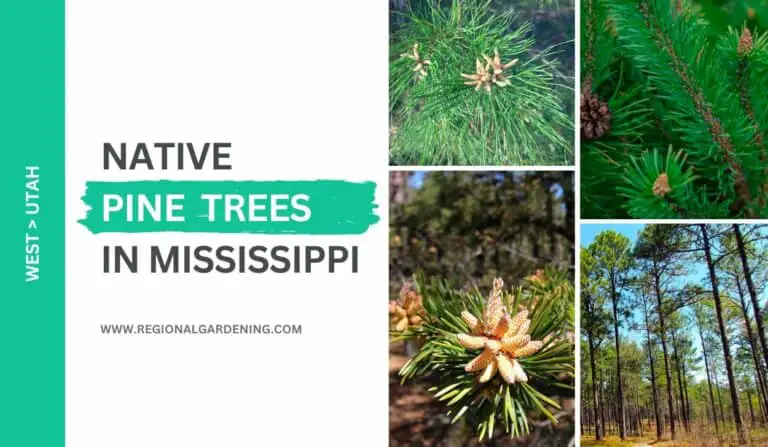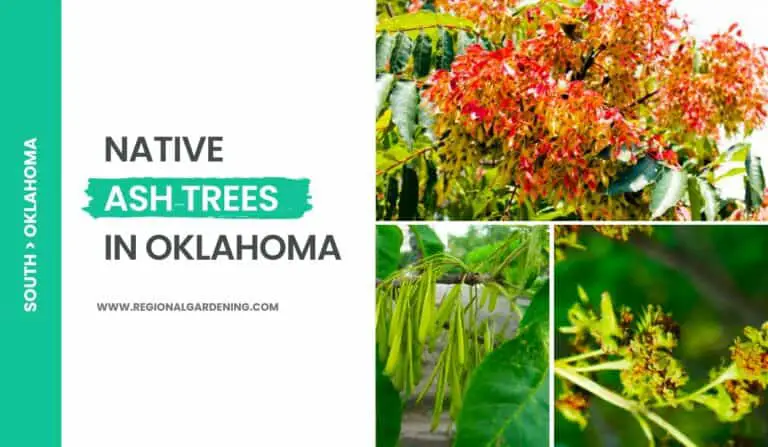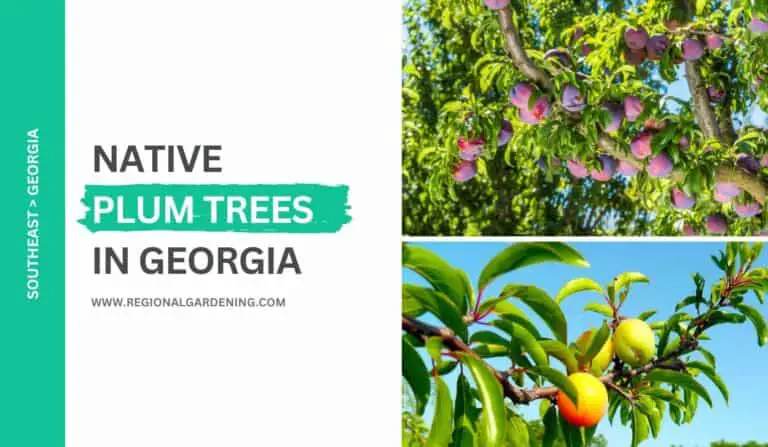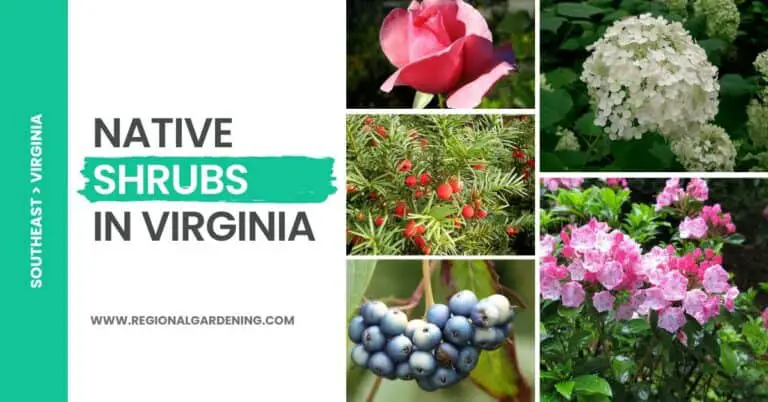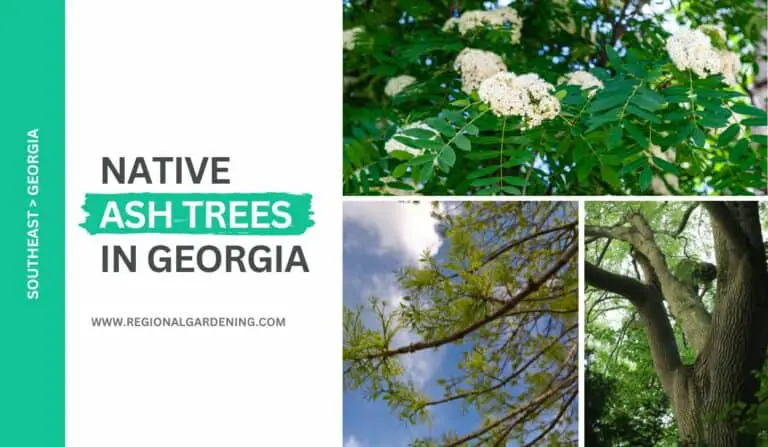11 White Flowering Trees In Georgia (Photos & Care Tips)
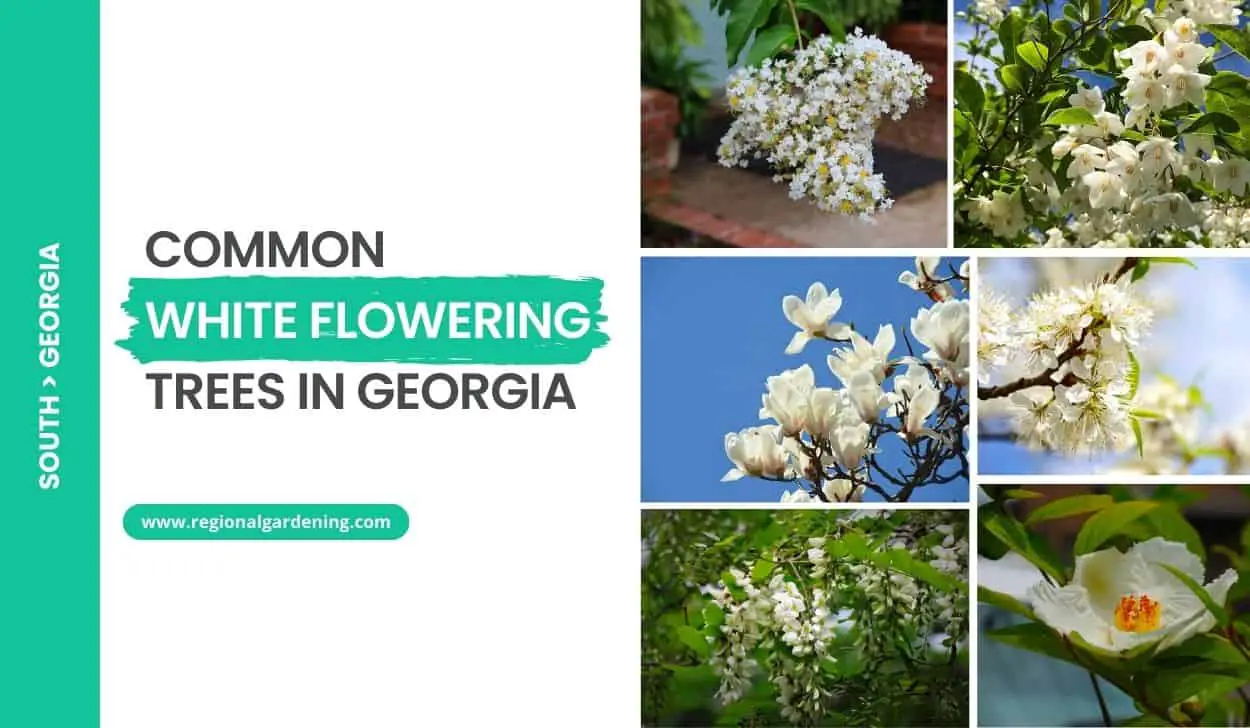
Georgia transforms into a canvas painted with the ethereal beauty of colorful flowering trees when spring arrives in the heart of the South. White flowering trees are always pristine and pleasing to the eyes. These iconic blossoms have long captured the hearts of locals and visitors alike, known for their pristine purity and timeless elegance.
In this article, we go on a tour of the Peach State’s landscape to learn about the 11 commonly found white-flowering trees in Georgia gardens, parks, and streets.
So, let’s begin with the dogwood, the most common among all the white flowering trees in Georgia.
1. Dogwood
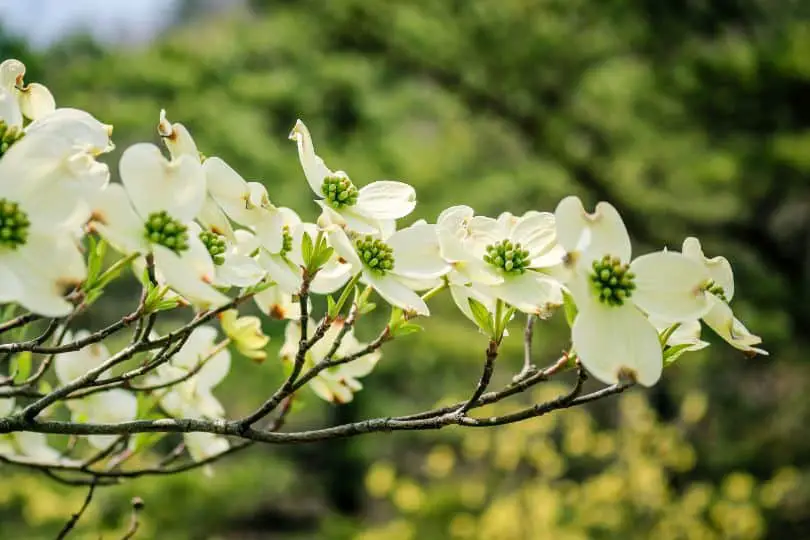
- Scientific Name: Cornus florida
- Common Name(s): Dogwood
- Mature Height: 20-30 feet (6-9 meters)
- Native Region: Eastern North America
- Flowers: White and pink flowers in a cross-shape
- Fruit: Red berries
- Uses: Landscaping, ornamental tree, wildlife attractor, wood crafting
The Dogwood (Cornus florida) is a deciduous tree endemic to Eastern North America. At maturity, it grows to a height of 20-30 feet (6-9 meters). The Dogwood is prized for its beautiful blossoms, which bloom in early spring and produce a lovely display. The flowers are white with pink tinges and form a unique cross shape. Because of this characteristic, the Dogwood has become connected with Christianity and is known as the “Christian Tree.”
In addition to its lovely blossoms, the Dogwood provides little red berries that provide food for wildlife, especially birds. Several kinds of butterfly larvae use the tree as a host plant.
In terms of growing conditions in Georgia landscapes, the Dogwood prefers well-drained soil and moderate shade to full sun. To promote optimal growth, it is critical to offer frequent irrigation, especially during dry months. The Dogwood is also adaptable to urban situations and tolerates a wide range of soil conditions.
Because of its aesthetic appeal and propensity to attract wildlife, the Dogwood is extensively utilized in landscaping. It can be planted as a single specimen or in clusters for a more dramatic impact. The wood of the Dogwood is solid and sturdy, making it ideal for woodworking projects like crafting tool handles and small furniture pieces.
2. Southern Magnolia
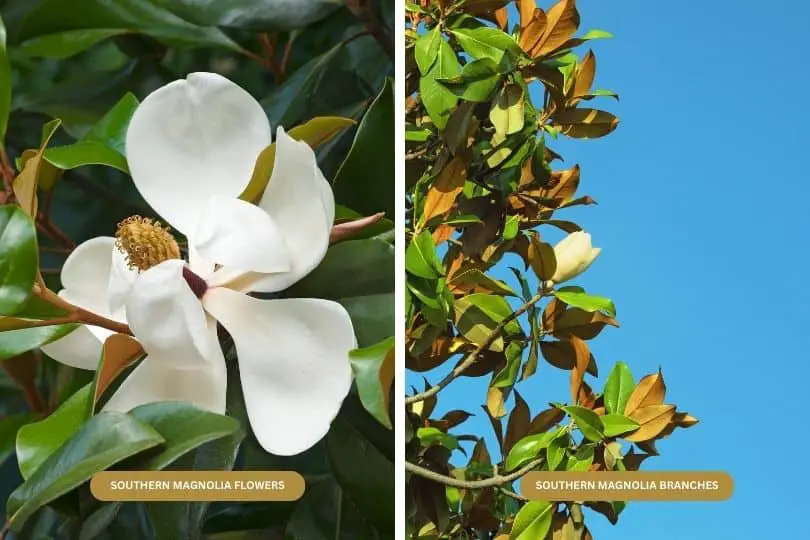
- Scientific Name: Magnolia grandiflora
- Common Name(s): Southern Magnolia
- Mature Height: 60-80 feet (18-24 meters)
- Native Region: Southeastern United States
- Flowers: Large, fragrant, white flowers that measure 6-8 inches (15-20 cm) in diameter, with a prominent lemony fragrance.
- Fruit: Cone-like fruit that contains bright red seeds.
- Uses: Often used as an ornamental tree in landscapes, the Southern Magnolia provides shade and beauty. The flowers are popular for floral arrangements due to their size and fragrance. The wood is used for carpentry and cabinetry.
The Southern Magnolia, scientifically known as Magnolia grandiflora, is a magnificent and widely planted tree in Georgia. When fully grown, this evergreen tree can grow to a height of 60 to 80 feet (18-24 meters). It is distinguished by glossy, dark green leaves with a leathery texture and a reddish-brown underside. When young, the bark of the Southern Magnolia is smooth and gray, but it becomes rough and brown as the tree ages.
The Southern Magnolia, a native of the southeastern United States, flourishes in Georgia’s warm and humid climate. It is frequently found in forests, wetlands, and along rivers and streams. Because of its large canopy and dense foliage, it is commonly employed as a shade tree in landscapes.
The Southern Magnolia’s big, fragrant blossoms are one of its most distinguishing characteristics. These white blossoms have a wonderful cup shape and can measure 6 to 8 inches (15-20 cm) in diameter. From late spring to early summer, they bloom and give a pleasant lemony smell that pervades the surrounding region. The blossoms attract pollinators such as bees and butterflies, adding to the tree’s beauty.
The Southern Magnolia produces cone-like fruit when the blooms fade. These fruits have vivid red seeds and, while they are not commonly used in cooking, they offer a splash of color to the tree and can attract birds.
The Southern Magnolia requires well-draining soil that is rich in organic matter to thrive in Georgia’s landscapes. It enjoys full sun to partial shade and, once established, is drought tolerant. During dry spells, regular watering and mulching are important. Pruning is required to keep the tree in form and to remove dead or damaged branches.
In addition to its decorative significance, the Southern Magnolia offers several functional uses. The huge and fragrant blossoms are frequently used in floral arrangements to add elegance and beauty. Southern Magnolia wood is prized for its strength and durability, making it a popular choice for carpentry and cabinetry.
3. Ornamental Pear
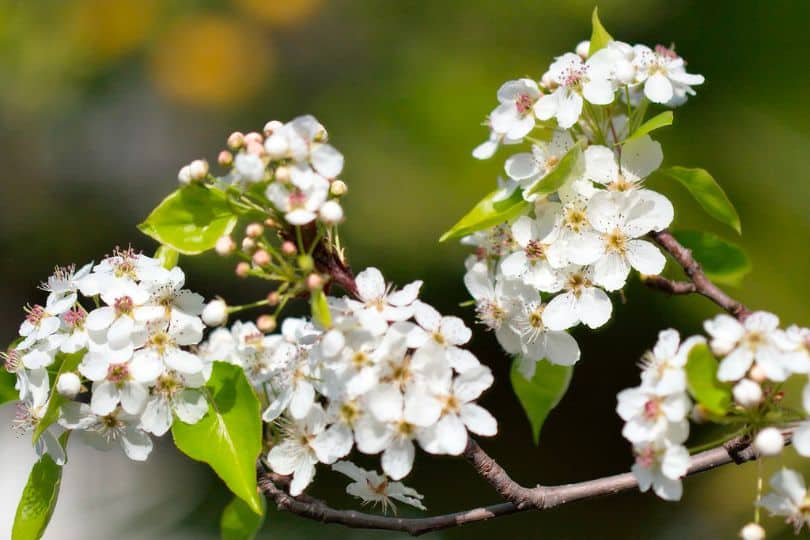
- Scientific Name: Pyrus calleryana
- Common Name(s): Ornamental Pear, Callery Pear
- Mature Height: 30-50 feet (9-15 meters)
- Native Region: China and Vietnam
- Flowers: Clusters of small, white flowers in early spring, typically in March or April
- Fruit: Small, brown pears that are not typically used for consumption
- Uses: Ornamental purposes, shade trees, can be used for screens, hedges, or windbreaks
The Ornamental Pear (Pyrus calleryana), often known as the Callery Pear, is a popular landscape tree in Georgia. It can reach maturity heights of 30 to 50 feet, making it an excellent shade tree. The Ornamental Pear is native to China and Vietnam, but it has spread to many other areas, including Georgia.
This tree is well-known for its clusters of small, white flowers that bloom in the early spring, usually in March or April. The aromatic blossoms attract bees and other pollinators. The delicate white blossoms stand out against the dark green, glossy leaves of the tree, adding to its decorative value.
Small brown pears appear when the petals fade, however, these fruits are rarely consumed. Instead, they give aesthetic interest and texture to the appearance of the tree. The pears may remain on the tree throughout the winter, giving some food for wildlife.
The Ornamental Pear is a low-maintenance tree that grows well in full sun to light shade. It tolerates a wide range of soil types but favors well-drained soil. This tree is also noted for its urban tolerance, making it appropriate for planting in urban and suburban landscapes. Once grown, it is moderately drought-tolerant, but it can benefit from regular watering, especially during periods of extended drought.
The decorative Pear is a popular decorative tree in both residential and business environments in Georgia. It can be used as a focal point, shade tree, or planted in rows to make screens, hedges, or windbreaks. Its early spring flowers and glossy leaves add a splash of color and elegance to any setting. Furthermore, the tree’s tough and upright growth pattern allows it to survive high winds.
4. Saucer Magnolia
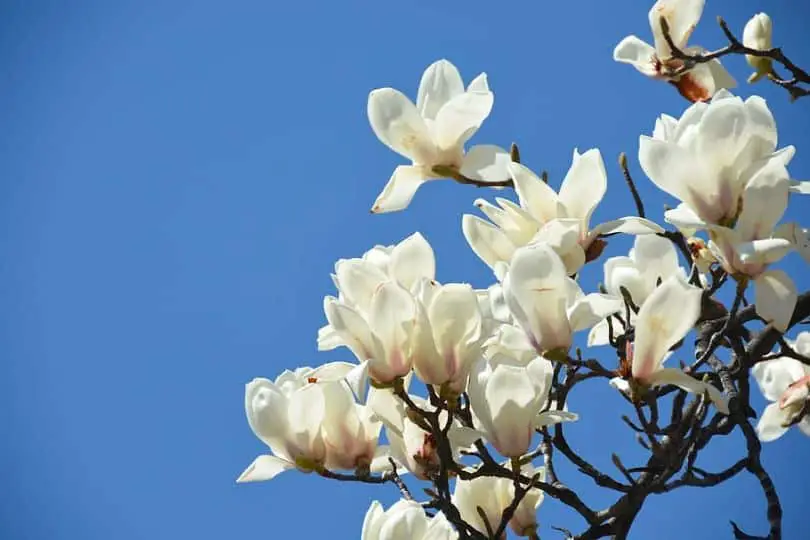
- Scientific Name: Magnolia x soulangeana
- Common Name(s): Saucer Magnolia, Tulip Tree, Chinese Magnolia
- Mature Height: 20-30 feet (6-9 meters)
- Native Region: Asia (China)
- Flowers: Large, showy, cup-shaped flowers in shades of white, pink, and purple.
- Fruit: Cone-like fruits with bright red seeds.
- Uses: Ornamental tree in landscapes, cut flowers for arrangements.
The Saucer Magnolia, also known as Magnolia x soulangeana, is a beautiful deciduous tree grown for its beautiful flowers. It can reach a height of 20-30 feet, making it an excellent choice for smaller landscapes. This tree, which is native to China, is well-suited to Georgia’s climate and may grow in a range of environments.
The Saucer Magnolia is distinguished by its huge, spectacular blossoms that look like saucers. The flowers range in hue from pure white to pink and purple tints. They have a wonderful cup shape and a delicious aroma, which attracts pollinators like butterflies and bees. The Saucer Magnolia normally blooms from late winter to early spring, before the leaves sprout.
In addition to its lovely flowers, the Saucer Magnolia has cone-like fruits with brilliant red seeds. While these fruits are rarely used in cooking, they do offer visual interest to the tree.
It is critical to pick a well-drained spot with full sun or light shade when planting a Saucer Magnolia in a Georgia environment. The tree prefers somewhat acidic soil and should be irrigated regularly, particularly during dry spells. It is low-maintenance once grown and can withstand some drought conditions.
The Saucer Magnolia is generally grown in landscapes and gardens as an attractive tree. Because of its exquisite and brilliant blossoms, it is a popular choice for adding color and elegance to any setting. Cut flowers are very popular for arrangements and may provide a touch of spring to any space. The Saucer Magnolia may thrive and become a center point in any Georgia landscape with proper care and maintenance.
5. Crape Myrtle
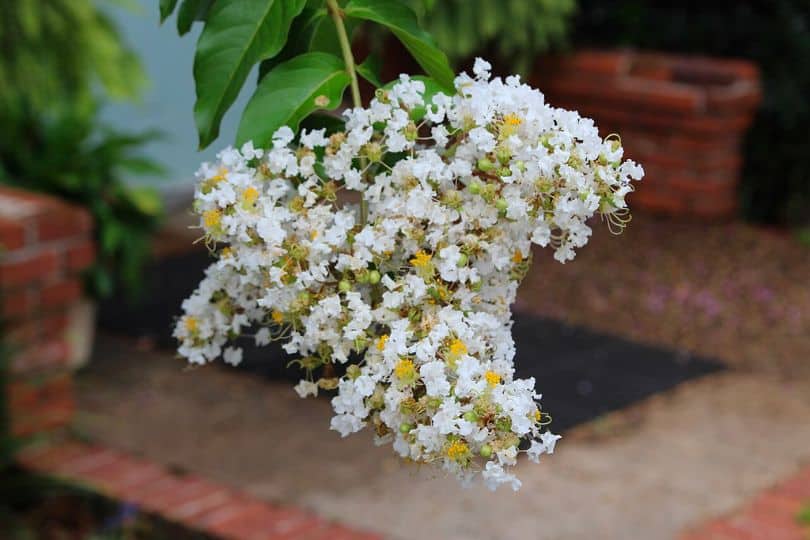
- Scientific Name: Lagerstroemia indica
- Common Name(s): Crape Myrtle
- Mature Height: 10–30 feet (3-9 meters)
- Native Region: Asia
- Flowers: The flowers of the Crape Myrtle come in a variety of colors, including white, pink, red, and lavender. They are small and arranged in large, showy clusters at the ends of the branches.
- Uses: Crape Myrtle is commonly used as an ornamental tree in landscapes due to its beautiful flowers and attractive bark. It can also be used as a shade tree in Georgia.
The Crape Myrtle is a small to medium-sized deciduous tree found in Georgia environments. It matures at a height of 10 to 30 feet (3 to 9 meters) and has a multi-stemmed growth habit. The leaves are simple and opposite, bright green during the growing season and reddish-orange in the fall.
Crape Myrtle, a native of Asia, thrives in Georgia’s environment and is commonly farmed in the region. It may grow in a variety of soil types, including sandy and clay, but prefers well-drained soil. For best growth and flowering, this tree requires full sun exposure.
The lovely flowers of the Crape Myrtle are one of its most remarkable characteristics. The flowers are available in several colors, including white, pink, red, and lavender. They are small and clustered in huge, spectacular clusters at the ends of the branches during the summer months, providing a magnificent display. The tree’s long-lasting blossoms attract butterflies and other pollinators, adding to its landscape appeal.
Crape Myrtle bears fruit in addition to being attractive. The fruit, on the other hand, is a minor aspect of the tree and is small, dry, and hard. It is grown mostly for its beautiful flowers and overall aesthetic appeal.
Once established, Crape Myrtle is a low-maintenance tree that requires little attention. It is drought-tolerant and can tolerate dry spells, making it an ideal choice for Georgia environments. Pruning is required to preserve a desirable shape and to remove dead or damaged branches and is often performed in late winter or early spring.
Crape Myrtle is a popular ornamental tree in both residential and business landscapes in Georgia. Its colorful blossoms and elegant bark provide year-round interest, and its adaptability to different soil types and drought tolerance make it a favorite choice for Georgia gardeners. It can also be used as a shade tree, providing relief from the summer heat.
6. Japanese Snowball
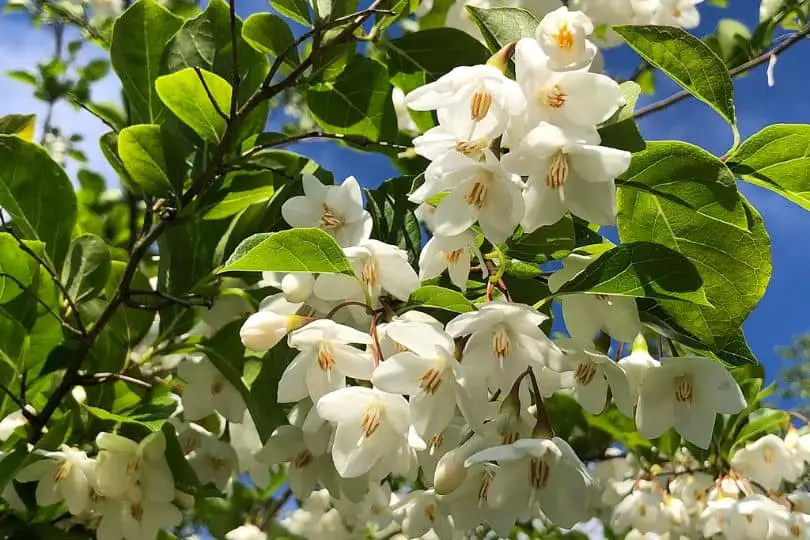
- Scientific Name: Styrax japonicus
- Common Name(s): Japanese Snowbell
- Mature Height: 20-30 feet (6-9 meters)
- Native Region: Japan, Korea, China
- Flowers: Bell-shaped white flowers
- Fruit: Small, round, olive-like fruits
- Uses: Ornamental tree, shade tree, suitable for small gardens or landscape features, can be grown as a bonsai tree
The Japanese Snowbell (Styrax japonicus) is a small to medium-sized deciduous tree that can grow to be 20-30 feet (6-9 meters) tall when mature. It’s native to Japan, Korea, and China, and it’s popular as an ornamental tree in Georgia landscapes and gardens. The tree is well-known for its graceful, spreading shape and lovely white blossoms.
The Japanese Snowbell is easily identified by its large, ovate leaves that are dark green in color and glossy. Mature tree bark is smooth and greyish-brown in hue. In the spring, the tree produces clusters of fragrant pendulous, bell-shaped white blooms. These blossoms dangle from the branches and form an eye-catching show, making the tree a popular ornamental choice.
The Japanese Snowbell produces small, spherical fruits that resemble olives after flowering. While these fruits aren’t especially eye-catching, they do give some visual interest to the tree. The Japanese Snowbell prefers well-drained soils and thrives in full sun to moderate shade for growth. It is also relatively tolerant of urban circumstances, making it appropriate for use in residential landscapes and gardens.
The Japanese Snowbell is commonly utilized as an accent tree in smaller gardens or as a focal point in landscapes in Georgia. The tree’s graceful form, lovely leaves, and spectacular blossoms make it a popular choice for designing an eye-catching garden. Because of its tiny size and superb beauty, the Japanese Snowbell is occasionally grown as a bonsai tree. Its fragrant blossoms and overall beauty make it a gardener’s favorite for adding a touch of elegance to their outdoor environments.
7. Star Magnolia
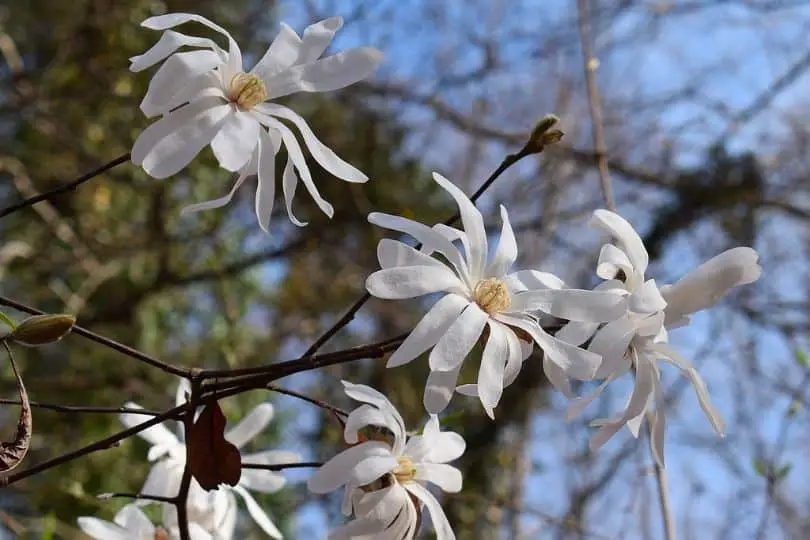
- Scientific Name: Magnolia stellata
- Common Name(s): Star Magnolia
- Mature Height: 15-20 feet (4.5-6 meters)
- Native Region: Japan
- Flowers: The star magnolia produces large, fragrant white flowers in early spring before the leaves appear. The flowers have a distinctive star-like shape, with numerous narrow petals.
- Uses: The star magnolia is a popular ornamental tree due to its beautiful flowers. It is often used as a specimen tree in gardens and landscapes.
The Japanese Star Magnolia (Magnolia stellata) is a tiny deciduous tree. It can reach a height of 15-20 feet and has several branches that stretch out to form a spherical appearance. The smooth, gray bark of the star magnolia contrasts nicely with its rich green leaves.
The blossoms of the star magnolia are one of its most distinctive characteristics. The star magnolia blooms in early April, before the leaves develop, and produces big, fragrant white flowers. These blooms have a distinctive star-shaped appearance, with multiple narrow petals radiating from the center. The popular name for the tree is Star Magnolia. The flowers are regarded as delicate and ethereal, and they make a lovely display in the landscape.
After the petals have faded, the star magnolia produces little round fruits that resemble cones. These fruits contain seeds that birds enjoy, and they can bring animals to the area.
The star magnolia grows in full sun to part shade and prefers moist, well-drained soil in Georgia environments. It requires little maintenance and is resistant to most pests and illnesses. The tree can be planted as a single specimen or in groups to add to the attractiveness of a garden or landscape. Many homeowners and gardeners prefer it because of its gorgeous blossoms.
Aside from its decorative value, the star magnolia has other advantages. In a garden, its dense branches and foliage can give shade and solitude. Furthermore, by filtering pollutants and creating oxygen, the tree can assist in improving air quality.
8. Japanese Stewartia
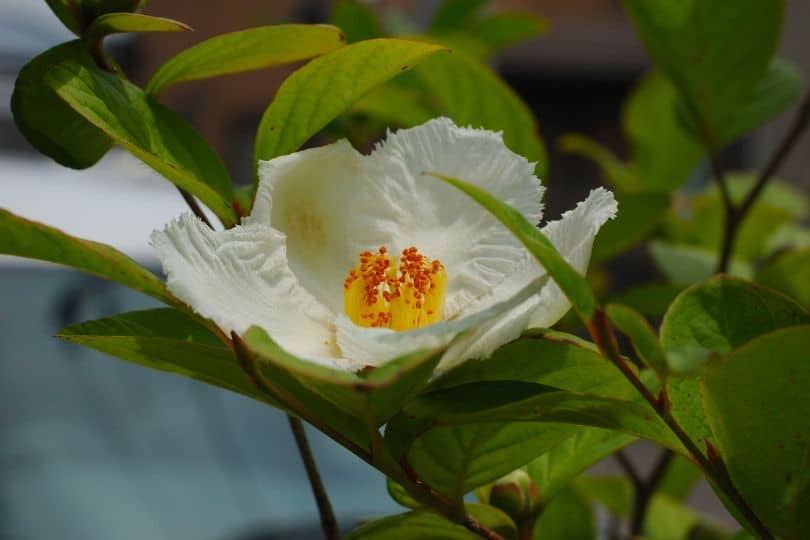
- Scientific Name: Stewartia pseudocamellia
- Common Name(s): Japanese Stewartia
- Mature Height: 20-40 feet (6-12 meters)
- Native Region: Japan, Korea, and China
- Flowers: White, camellia-like flowers with yellow centers
- Fruit: Capsule-like, woody fruits
- Uses: Japanese Stewartia is often cultivated for its ornamental value in gardens and landscapes. It is also used in bonsai cultivation.
Japanese Stewartia, also known scientifically as Stewartia pseudocamellia, is a lovely white flowering tree native to Japan, Korea, and China. It is frequently cultivated in gardens and landscapes for its ornamental appeal, notably in Georgia. The mature height of Japanese Stewartia is 20-40 feet (6-12 meters), making it a medium-sized tree.
The white blossoms of Japanese Stewartia, which mimic camellia petals, are one of its most appealing aspects. The flowers are eye-catching, with white petals and a contrasting yellow core. In early June, they blossom, providing a touch of elegance and beauty to the scene. The blossoms attract bees and other pollinators, making it an important tree for local species.
Japanese Stewartia produces capsule-like, woody fruits that provide interest to the tree during the fall season, in addition to its gorgeous flowers. Humans do not often consume fruits, but they are an important food source for wildlife.
Japanese Stewartia thrives in well-drained soils and full sun to partial shade conditions, making it ideal for Georgia landscaping. Once grown, it favors acidic soil and can withstand light drought. The leaves of the tree are a vivid mix of red, orange, and yellow in the fall, adding to its decorative appeal.
Because of its lovely blossoms, appealing bark, and general ornamental value, this tree is often employed in urban landscapes, parks, and private gardens. Due to its naturally small stature and delicate features, it can also be nurtured as a bonsai tree. Japanese Stewartia is an eye-catching addition to any landscape, providing beauty and intrigue throughout the year.
9. Sourwood
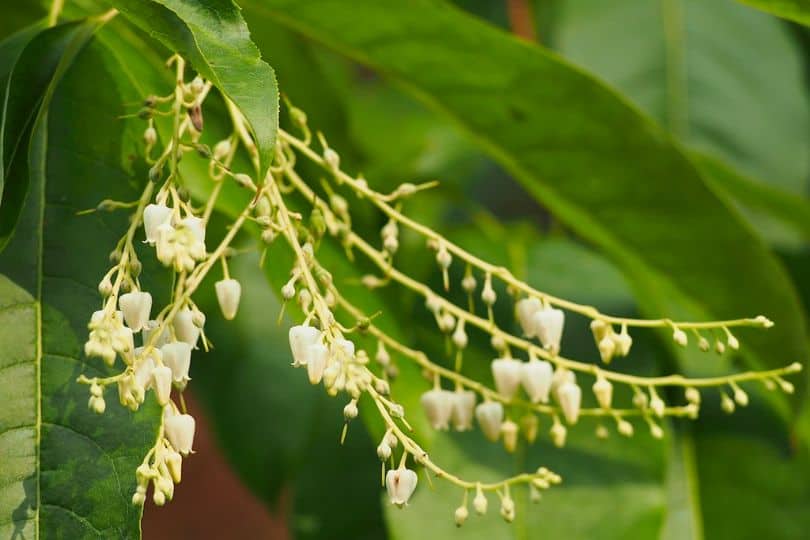
- Scientific Name: Oxydendrum arboreum
- Common Name(s): Sourwood
- Mature Height: 25-50 feet (7.6-15.2 meters)
- Native Region: Eastern North America
- Flowers: Clusters of fragrant, white, bell-shaped flowers
- Fruit: Small capsules containing winged seeds
- Uses: Ornamental tree, honey production, timber
Sourwood (Oxydendrum arboreum) is a deciduous tree that grows to be 25-50 feet (7.6-15.2 meters) tall. It is indigenous to eastern North America, particularly Georgia. The tree is well-known for its lovely white blooms, which bloom in clusters during the summer. The fragrant, bell-shaped flowers are a lovely addition to landscapes.
The sourwood tree’s leaves are simple and alternating, approximately 5-8 inches in length. During the summer, they have a glossy, dark green color and in the fall, they change vivid shades of crimson, orange, and purple, creating stunning autumn foliage. The tree’s bark is rough and grayish-brown.
Sourwood is extremely adaptable, growing in a variety of soil types, including acidic, well-drained soils. For optimal development, it prefers full sun to partial shade. Because of its tiny stature, the tree is excellent for both large and small settings.
The sourwood tree’s blossoms are the main draw. They have a bell-shaped structure and are white in hue. The flowers form long, drooping clusters that can grow up to 8 inches long. Because the aroma of the flowers attracts pollinators, particularly bees, sourwood is an excellent tree for honey production.
Small capsules holding winged seeds form after the flowers fade. During the late summer and early fall, these capsules offer aesthetic appeal to the tree. The wind disperses the seeds, assisting in the tree’s natural propagation.
Because of their lovely blossoms and stunning fall foliage, sourwood trees are widely employed as ornamental trees. The tree is also an important source of nectar for bees, allowing honey producers to produce sourwood honey, which is recognized for its distinct flavor. Sourwood wood is often utilized in the manufacture of tiny specialty products such as furniture, boxes, and musical instruments.
10. Black Locust
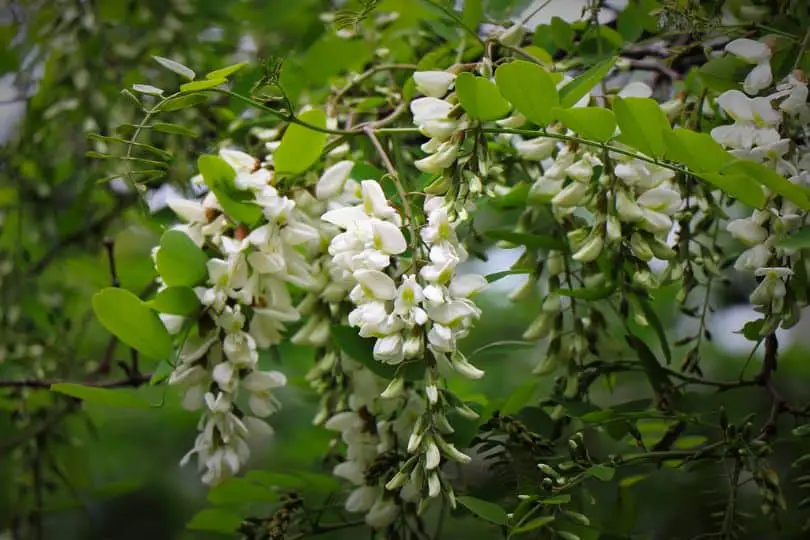
- Scientific Name: Robinia pseudoacacia
- Common Name(s): Black Locust, False Acacia
- Mature Height: 30-50 feet (9-15 meters)
- Native Region: North America
- Flowers: The Black Locust produces fragrant white flowers in pendulous clusters. The flowers have a sweet aroma and attract pollinators such as bees and butterflies.
- Fruit: The tree produces flat brown seedpods that contain small, hard seeds.
- Uses: Black Locust is commonly used in landscaping for its attractive white flowers and shade. Its wood is highly valued for its durability and is often used for fence posts, furniture, and fuel.
The Black Locust, scientifically known as Robinia pseudoacacia, is a deciduous tree prevalent in Georgia’s landscapes. It has a native range in North America and can reach mature heights of 30-50 feet (9-15 meters). The tree’s dark, deeply furrowed bark, and prominent pyramid-shaped crown make it easy to identify.
The Black Locust’s leaves are pinnately compound, with each leaflet oval-shaped and smooth-edged. In late spring or early summer, the tree produces fragrant white flowers in pendulous clusters. The blossoms have a lovely perfume and are a nectar source for bees and butterflies. The Black Locust is hence a popular choice for attracting pollinators to gardens and landscapes.
Following the flowering season, the tree produces flat brown seedpods containing small, firm seeds. These seedpods remain on the tree throughout the winter, adding aesthetic interest.
The Black Locust thrives in full sun and well-drained soil in Georgia landscapes. It is well-known for its capacity to adapt to various soil types, especially clay and sandy soils. Once planted, the tree is drought-resistant and requires little care. It can withstand mild pollutants, making it acceptable for use in cities.
Aside from its visual value, the Black Locust has a variety of purposes. Its wood is widely prized for its toughness and rot resistance, making it an attractive choice for fence posts, furniture, and outdoor buildings. The tree can also fix nitrogen, which enhances soil fertility and makes it a valuable contribution to the environment.
11. American Plum
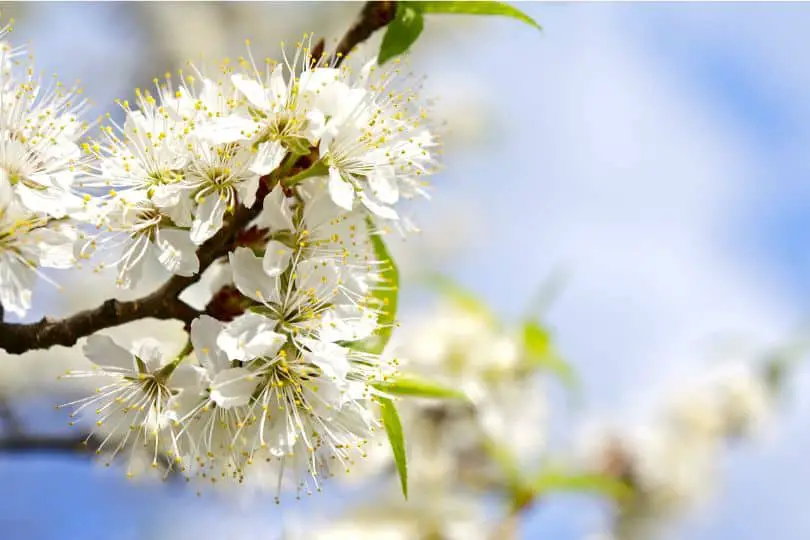
- Scientific Name: Prunus americana
- Common Name(s): American Plum
- Mature Height: 15-25 feet (4.5-7.6 meters)
- Native Region: North America
- Flowers: White, five-petaled flowers in early spring
- Fruit: Small, round red plums that are edible and have a sweet-tart flavor
- Uses: The American Plum is often used as an ornamental tree in landscapes and provides food for wildlife. The fruits can be used to make jams, jellies, and pies.
The American Plum (Prunus americana) is a deciduous tree that can grow to be 15 to 25 feet (4.5 to 7.6 meters) tall when mature. It is native to North America and can be found throughout the continent.
The green oval-shaped leaves of this tree turn yellow in the fall, bringing a splash of color to the scene. The bark of the American Plum is reddish-brown and develops an appealing scaly texture as the tree becomes older.
The American Plum’s stunning white blooms, which bloom in early spring, are one of its greatest attractions. When the tree is in full bloom, these five-petaled blossoms offer a magnificent display. The flowers not only beautify the landscape, but they also supply nectar for bees and other pollinators.
The American Plum bears small, spherical red plums in late summer. These fruits have a sweet-tart flavor and are edible. They are loved by wildlife such as birds and mammals, and they can also be collected for culinary purposes by humans. Plums can be used to produce jams, jellies, and pies, which lend a delightful flavor to any recipe.
The American Plum grows well in a variety of soil types and can withstand both wet and dry conditions. It is a tough and versatile tree that can weather harsh winters as well as hot summers. To achieve the best development and fruit production, the American Plum should be given full sun exposure in Georgia environments.
The American Plum is a useful tree for animals in addition to its decorative significance. It offers food for birds and mammals, contributing to the ecosystem’s biodiversity. It also makes an excellent addition to edible landscapes because the plums can be plucked and consumed by humans. The American Plum is a favorite choice for Georgia landscapes because of its lovely flowers, elegant leaves, and valuable fruits.
Similar Articles
- Native Oak Trees in Georgia
- Native Pine Trees In Georgia
- Native Hickory Trees In Georgia
- Native Maple Trees In Georgia
- Native Tupelo Trees In Georgia
- Native Plum Trees In Georgia
- Native Magnolia Trees In Georgia
- Native Willow Trees In Georgia
- Native Ash Trees In Georgia
- Native Elm Trees In Georgia
- Native Dogwood Trees In Georgia
- Native Cottonwood Trees In Georgia
- Native Cedar Trees In Georgia
- Common Birch Trees In Georgia
- Common Cypress Trees In Georgia
- Common Pink Flowering Trees In Georgia
- Common Palm Trees In Georgia
Common White Flowering Trees In Georgia – Sources
The Regional Gardening team makes sure that the information in our articles is accurate by only using sources that are known to be trustworthy. Some of these sources are peer-reviewed journals from government agencies, well-known universities, and scientific research organizations.
- Georgia Native Plant Society
- College Of Agricultural & Environmental Sciences, University Of Georgia
- Native Plants Books, Georgia Native Plant Society
- Georgia Forestry Commission
- Native Plants Of North Georgia, University Of Georgia
- Tree Care, Georgia Tree Council


